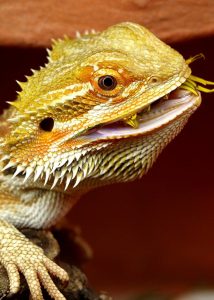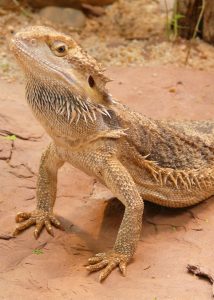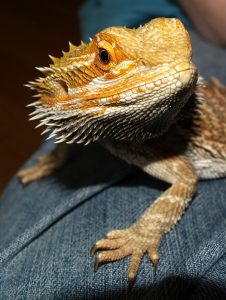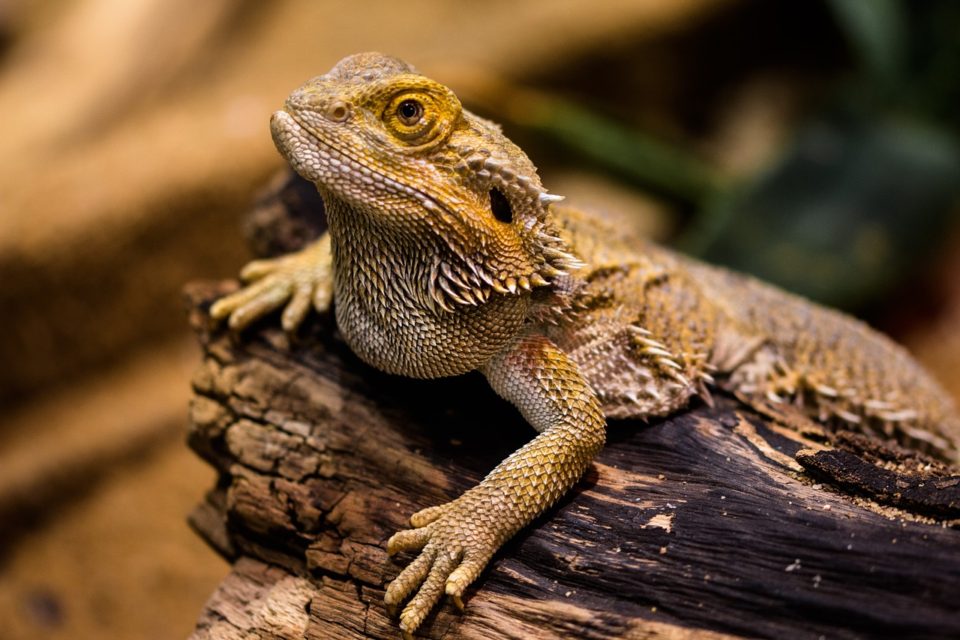Whether you’re a seasoned herpetoculturist – someone who raises live reptiles and amphibians – or a beginner pet owner, the bearded dragon is an extremely popular lizard that is both easy and fun to raise.
Native to Australia, bearded dragons, also known affectionately as ‘beardies’ were first introduced into the United States as pets in the 1990s, and they have been stealing hearts ever since.
If you’re interested in owning one yourself, it’s important to learn what exactly you need to help them live a healthy, comfortable life.
What Do You Need for a Bearded Dragon Enclosure?
Bearded dragons don’t need much to be happy and healthy. They’re hardy and easily pleased – one reason that they are such popular beginner pets.
First, you should buy a properly sized enclosure. Make sure to take into account how big your bearded dragon will grow when choosing the right enclosure.
Next, you will need to invest in the proper lighting. Bearded dragons require two main types of lights: a UV light which mimics the sunlight to provide UVB light and a heat light to provide warmth.
Bearded dragons rely on UVB light to help them produce Vitamin D, which keeps their bones healthy, and they rely on the heat light because, as ectotherms, they cannot regulate their own body heat.
Perches in the form of rocks and limbs can also make your bearded dragon’s enclosure more comfortable. Finally, you will need substrate, which lines the bottom of the enclosure.
Why do Bearded Dragons Need Substrate?
Take a second and think about it this way. Remember how I mentioned bearded dragons were native to Australia? Allow me to be a bit more specific.
The Inland Bearded Dragon – which is the most popular bearded dragon kept as a pet – is native to the arid woodlands and deserts of central Australia.
This means that, in the wild, they spend their time walking on the warm ground, basking on rocks in the Australian sunlight, and hiding in foliage – not walking on a glass floor.
Substrate helps keep your beardie comfortable and mimics their natural habitat. With that being said, you have many options for substrate, some better than others.
What are the Different Types of Bearded Dragon Substrate?

There are five main types of substrate that you can use in your bearded dragon’s enclosure. Each one offers different benefits, however, some can pose a risk for gut impaction.
It’s important to do your research and, if you choose to pick a potentially riskier substrate, monitor your bearded dragon during feed times. To help you pick, here is an overview of each substrate.
Sand and Similar Alternatives
In the deserts of Australia, bearded dragons spend their days running across the blazing sands, making this substrate the most realistic.
Some owners prefer to add in gravel and small rocks to enhance this effect. However, during feeding, it is possible for your bearded dragon to accidentally swallow some of this substrate.
This can lead to gut impaction, a potentially fatal condition where the intestines become blocked. If you would still like to use sand as your substrate but want to avoid these complications, there is hope.
First, only use sand if you have an adult bearded dragon. They have more experience with catching their food and have less of a chance of accidentally swallowing the sand or pebbles.
You can also invest in alternatives that replicate sand without posing the same threat. One of the main alternatives used, which will be discussed later, is called Vita Sand.
Newspaper
While newspaper may not be the most aesthetically pleasing substrate, it is one of the safest, and you can use it in enclosures with both juvenile and adult bearded dragons.
It’s also the cheapest option. The biggest problem is the fact that newspaper retains humidity.
However, if you’re willing to clean it regularly, your bearded dragon will love digging and burrowing in the shredded paper.
Ceramic Tile
Ceramic tiles are one of the new trends in the herpetoculture community.
Sleek, professional, and almost completely customizable, it’s not a surprise that more and more of these are popping up in bearded dragon enclosures all across the world.
Their main benefits are that they are easy to clean and completely eliminate the risk for impaction. However, your bearded dragon won’t be able to dig and burrow.
Bark and Mulch
While mulch is an option for a substrate, it’s one of the least preferred. Like newspapers, it retains an abundance of humidity, raising the temperature of the enclosure.
However, unlike newspapers, it’s difficult to clean. Bark and mulch are some of the cheaper options, but, if possible, it’s better to invest in a higher quality substrate.
Reptile Carpets and Cage Liners
These substrates, as their name suggests, are designed specifically for reptile enclosures. Reptile carpets are synthetic cage liners that replicate the bearded dragon’s natural habitat.
They’re easy to install, easy to clean, and have little risk of impaction.
It is extremely important, however, to make sure you tuck the cage liner in tightly; otherwise, your bearded dragon will be at risk for snagging, or even ripping off, their claws.
Top 12 Best Substrate for Bearded Dragons
Here are the top 12 substrates from every type! Of course, newspapers will not be included as you don’t need to shop online for these.
Just swing by your local gas station or grocery store and you can find the daily copies.
Sand
1) Zoo Med Vita Sand
This is the sand alternative I mentioned earlier, and it is designed specifically to help beat the problem of gut impaction.
Vita Sand is a lot like regular sand: it’s available in six colors and easy to clean. However, unlike regular sand, it is much safer to use as a substrate for your bearded dragon’s enclosure.
First, it’s fortified with calcium carbonate and beta cantone without including fat-soluble vitamins that can be potentially fatal in large doses.
It is also super fine to help reduce the risk of gut impaction. While these benefits are wonderful, they don’t mean that Vita Sand is completely free of risks.
You should still use caution and supervise during feedings. After all, it’s better to be safe than sorry.
Also, while more of an inconvenience than a problem, this substrate can be dusty when poured, so you may want to open a window or two.
2) Reptile Science Terrarium Sand
Vita Sand isn’t the only safer sand alternative. The Reptile Science terrarium sand comes either in single packs or bundles of two, three, or four packages.
100% digestible to help prevent impaction, this substrate is free of harmful ingredients such as silica and phosphate.
Instead, it’s made of calcium carbonate. While it offers a safer alternative to natural sand, it also neutralizes odors, helping reduce any foul smells from escaping into your home.
There are a few things to remember if you choose to purchase this substrate, however.
First, like all sand substrates, you will need to supervise your bearded dragon during feedings. Second, Reptile Science terrarium sand only comes in one color.
3) Carib Sea Reptiles Calcium Substrate
With its desert rose color, the Carib Seas substrate definitely looks like its fresh from the arid deserts of Australia.
This substrate is made out of a soluble form of calcium carbonate known as aragonite.
While it is free of harmful ingredients such as phosphates and silicas, it is full of nutrients such as magnesium so that, if your bearded dragon does accidentally ingest some of the sand during feedings, it won’t just not harm them but offer helpful, healthy nutrients.
It’s also designed in a way to be fine enough so that it won’t scratch your bearded dragon as they move about their enclosure.
While it is a bit more on the expensive side, it offers many benefits, including low dust.
Tile
As a note before you begin, if the tiles are something you are interested in implementing in your bearded dragon’s enclosure, then just know that almost every type of tile is okay.
However, it is highly recommended that you avoid tiles made out of material such as granite or marble. These stones are extremely porous and will absorb water.
4) 12-Pack Glossy White Glazed Ceramic Tiles
Sometimes simple is best. This pack of 12 tiles is perfect for your bearded dragon’s enclosure.
When picking tiles, it’s important to make sure the paint is non-toxic.
While these tiles are free of any colored paint – which means you can rest easy – they are also free of any harmful components.
The sides are smooth allowing them to both fit together easily and remain safe so that your beardie doesn’t get cut or injured while playing.
5) Diflart White Ceramic Subway Tiles
If your bearded dragon’s enclosure is the center of attention in your living room, and you want a nice, clean, minimalistic look, then these ceramic subway tiles are a great option.
These are also free of any harmful, toxic components, so you don’t have to worry about your bearded dragon’s health.
They have free two day shipping, and, if any of the tiles arrive damaged or broken, Diflart will replace them for free.
Bark and Mulch
6) Zoo Med Repti Bark
With 8 purchasing options in the form of different sizes and bundles, the Zoo Med Repti Bark is definitely one of the most versatile options.
It’s all natural, so it’s safe to put in your beardie’s enclosure without any worries of harmful side effects.
Like nearly all mulches and barks, it is hygroscopic – which means it absorbs moisture and produces humidity – so you will need to keep an eye on the temperature of your beardie’s enclosures.
Other than that fact, though, this substrate is safe, easy to clean, and allows for your bearded dragon to burrow and dig to their heart’s content.
While most mulch substrates need to be replaced every few months, Zoo Med stays good for use for up to a year, so long as you soak the wood chips every three or so months to keep them clean and fresh.
One of the best things about this substrate is that, so long as you do follow the instructions and soak it, it is reusable.
7) Zoo Med Forest Floor Bedding
If you’re more interested in recreating the arid woodlands and forests part of a bearded dragon’s natural habitat rather than the desert, then this is the substrate for you.
It maintains moisture and humidity and is easy to clean. It’s also made out of natural cypress mulch, allowing you to know exactly what you are putting into your bearded dragon’s enclosure.
If you’re worried about mites from storage, you can freeze the Zoo Med Forest Floor bedding for a few days, and, after allowing it to thaw back to room temperature, fill the enclosure.
8) Exo Terra Coco Husk
Available in either a 3.6-quart bag or a 7.2-quart bag, this 100% natural substrate is perfect for any enclosure.
It increases humidity – which is good if you live in drier areas but should be avoided if you live in areas with high humidity already – and encourages your bearded dragon to fulfill their instinct to dig and burrow.
Reptile Carpets and Cage Liners
As a reminder, reptile carpet is one of the safest options for your bearded dragon, as there is no chance of ingestion or gut impaction.
However, beware of holes or rips that can snag your bearded dragon’s claws, and make sure to provide toys and other entertainment to make up for the lack of ability to dig.
9) Hamiledyi Reptile Carpet Natural Coconut Fiber
Coming in a pack of two, the Hamiledyi carpet is made of all natural coconut fiber that is both aesthetically pleasing and safe for your bearded dragon.
It reduces odor and can be cleaned by simply using cold water – hot water can damage the carpet.
While coconut fiber may not sound like the nicest material, these mats, which can be cut into any shape you desire, are designed to be non-abrasive so that you don’t have to worry about your bearded dragon getting injured while moving about their enclosure.
It also holds heat, just like sand, so you don’t have to worry about the bottom of your bearded dragon’s enclosure being too cold.
10) Zilla Reptile Terrarium Bedding Substrate Liner
The Zilla Reptile liner is available in 8 sizes ranging from 10 gallons to 125 gallons and in two colors, allowing you pick the liner that best fits the needs of your bearded dragon.
The liner is treated with a biodegradable enzyme that helps reduce odors and is made of nonabrasive materials that will keep your bearded dragon’s sensitive skin harm free.
To install, simply roll out the liner and cut to the size and shape you prefer. When cleaning time comes, all you have to do is rinse it with cold water.
The only downside to cleaning liner over loose substrate is that you must remove all of the decorations with every cleaning.
11) Zoo Med Reptile Cage Carpet
This is a great beginner pack! The Zoo Med Reptile carpet is designed for a 10 gallon cage and comes in a bundle with two packages with two pieces of carpet each – four pieces of carpet in total.
They’re relatively inexpensive, and they are made of all natural materials so you don’t have to worry about your bearded dragon. Like most other liners, you can just rinse this off to make it good as new.
12) Zoo Med Eco Carpet
Designed for 40 gallon tanks, this reptile carpet is made out of cotton, making it soft, absorbent, and non-abrasive.
One thing to know before buying this carpet, though, is that it is advertised for a 40 gallon enclosure, it runs small.
Many customers either buy two and cut them to size or a buy the option for the 55 gallon and cut it to size.
The Zoo Med Eco carpet can be washed on cold and gentle without detergent and then hung to dry according to one customer, so cleaning is a breeze. This carpet only comes in green.
What to Consider When Choosing a Substrate
One of the main things to consider when choosing a substrate isn’t brand or style or even cost – though all of these things are important and should be considered later – but your and your bearded dragon’s lifestyles.
If your bearded dragon loves burrowing and digging, then purchasing a substrate that is solid such as a carpet liner or tile isn’t going to be your best choice.
If you have a busy life and struggle to squeeze even five minutes of free time into each and every day, then you’re not going to want to add in another daily responsibility.
In this case, stray away from sand and newspaper substrates that have to be cleaned daily.
Once you decide which type of substrate best fits your needs, then you can start considering things such as quality and brand.
How Often Should You Change Your Bearded Dragon’s Substrate?
Since I’m talking about how newspaper and sand needs to be cleaned daily, now is a good time to mention how often you should change all types of substrate.
Sand
Sand is a lot like litter – sands clumping of course. While it is the most natural substrate for your bearded dragon, it gets really dirty really quick.
Like litter, you should scoop out any visible waste or wet spots daily. You should completely change out your sand substrate once a week.
Most sands can last without being replaced for five to six months, but you should use your best judgement and replace whenever you notice that most of the sand is soiled.
Newspaper
 The same rules go for newspaper substrate as sand. Newspapers are highly absorbent. which is a good and bad thing.
The same rules go for newspaper substrate as sand. Newspapers are highly absorbent. which is a good and bad thing.
It’s good because, hey, you won’t have water sloshing all around! It’s bad because, especially in the case of feces and urine, it can create a bacteria breeding ground.
Make sure to clean and replace soiled areas daily to prevent infections and tail rot, and, depending on how many bearded dragons you have in a single enclosure, replace once or twice a month.
Tile
When it comes to cleaning your bearded dragon’s substrate, tile is the easiest, most time efficient option.
So long as the tiles never become damaged, you will never have to replace them, and, to clean them, all you have to do is wipe them down to remove any dirt or waste.
Bark and Mulch
Bark and mulch need to be replaced and cleaned just as often as sand and newspapers.
If you live in an extremely humid climate, you may want to replace it more often as mulch is highly absorbent and will hold humidity.
Reptile Carpet and Liners
Reptile carpet lasts the second longest out of your substrate options.
As long as you clean any wastes or dirt that is dirtying up your bearded dragon’s enclosure, and you make sure that there is no damage to the liner itself such as tears or holes, it’s good to go!
To keep everything in tip-top shape, you should replace your liner once or twice a year.
Why Should You Replace and Clean Substrate Regularly?
You should regularly replace and clean your bearded dragon’s substrate for the same reason that you should clean your sheets or pillowcases or towels – it’s just the healthy, hygienic thing to do.
A dirty enclosure can lead to an entire slew of problems ranging from simple aesthetic issues to even death.
After a few days of not cleaning your bearded dragon’s enclosure, you may notice an unpleasant odor, and the enclosure won’t look as nice.
If you continue to neglect cleaning, bacteria can spread to both your bearded dragon and you. You may notice that your bearded dragon will begin acting uncharacteristic.
Lethargy and aggression aren’t uncommon when your bearded dragon is either ill or uncomfortable in their enclosure.
Cleaning regularly will help prevent these issues while keeping your bearded dragon healthy, happy, and safe.
What Can You Do to Make Substrate More Comfortable?
Making your bearded dragon as comfortable as possible doesn’t end with purchasing the right substrate!
You can buy toys and perches and many other things to make your bearded dragon happy. You can also purchase a substrate heater.
A substrate heater does exactly what you think – heats the substrate! You can either purchase one as an extension to your enclosure or purchase an enclosure, such as an Exo Nano terrarium, that has one built in.
A substrate heater will help mimic the warm desert sands of Australia while also helping maintain the temperature of the enclosure.
Certain types of heaters may not be compatible with certain types of substrates, however, so, like always, make sure to do your research to make sure your bearded dragon is as safe and happy as possible.
Best Substrate for Bearded Dragons: Top Picks
You’ve learned a lot during this! Because it’s such a large amount of information to take in at once, and you might still be a little lost on picking the best substrate for your bearded dragon, here are my top picks!
Sand
With the sand substrate, I tried to focus on which option seemed both the safest and the most beneficial, and, in the end, I chose Reptile Science Terrarium Sand.
This substrate isn’t just safe for your bearded dragon with its 100% digestible, non-toxic ingredients, but it also offers many other benefits.
I especially like the fact that it neutralizes smell since a large issue with many types of sand substrate is a dusty, unpleasant scent.
Tile
This one was a bit of a hard decision if I’m being honest.
All types of tiles are very similar, so it’s hard to pick a product that really stands out. From the two that I have listed above,
I have to say that my top pick is the Diflart Ceramic Subway Tiles. While I am just a sucker for the subway tile style – it’s just so cute and minimalistic!
I also like the added benefits such as free two day shipping and the warranty.
Bark and Mulch
While I don’t recommend bark as a substrate for novice bearded dragons owners, if you have experience and prepared to put the extra work and supervision in to monitor humidity and temperature levels, I think it can work just fine.
If you do choose to use bark, then my top choice would have to be the Zoo Med Repti Bark.
Most barks and mulch are created equal, with the only main differences being the plant matter used to create the mixture, so I tried to look at other components, and I really like the fact that this mulch is reusable and lasts for a year.
It’s sustainable and budget friendly – an overall good choice when paired with its efficiency.
Reptile Carpet and Liners
For the liners, I chose the Hamiledyi Reptile Carpet Natural Coconut Fiber due to the fact that it is easy to clean, safe to use, and offers additional benefits such as heat retention.
Overall: Best Substrate for Bearded Dragons
My overall top choice for a bearded dragon substrate would have to be the Hamiledyi Reptile Carpet Natural Coconut Fiber.
As mentioned right above, I really like the fact that it incorporates the best characteristics from each other type.
It’s easy to clean like tiles, retains heat like sand, and, most of all, it’s extremely safe and budget-friendly.
Sustainability and all natural ingredients is important to me as well, and this liner really hits the mark. It also neutralizes odors, a characteristic any pet owner will appreciate.
I think that this is also the best choice for beginners and experienced bearded dragon owners.
Final Thoughts: Best Substrate for Bearded Dragons
 From hardwood floors to linoleum to carpet, you have so many options when choosing flooring for your home and your bearded dragon does too!
From hardwood floors to linoleum to carpet, you have so many options when choosing flooring for your home and your bearded dragon does too!
In fact, they have five main options for a substrate, each with its own pros and cons.
For example, you have sand, which retains heat and mimic the bearded dragon’s natural habitat but needs regular cleaning and can pose a risk for gut impaction.
Then, you have newspaper, which is one of the safest options for beardies of all ages but needs to be replaced option.
Tiles are easy to clean and have a nice aesthetic, but your bearded dragon won’t be able to dig and burrow, and so on.
Each option needs to be carefully considered so you can see what fits not just your lifestyle, but your bearded dragons.
You need to keep it clean and hazard-free, and, if you want to make your beardie feel extra luxurious, you can invest in a substrate warmer.
Helping your bearded dragon feel at home in their enclosure is one of the best things you can do as their owner.
They’ll appreciate the time and thought you have put into making them comfortable and healthy.













